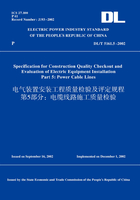
Foreword
Specification for construction quality checkout and evaluation of electric equipment installation is a series of standards for construction quality checkout,acceptance and evaluation of electric equipment installation.
The set of standards is comprised of the following 17 parts:
—Part 1:General rules;
—Part 2:High-voltage electric equipments;
—Part 3:Power transformers,oil-immersed type reactors and instrument transformers;
—Part 4:Busbar equipments;
—Part 5:Power cable lines;
—Part 6:Grounding devices;
—Part 7:Rotating electrical machines;
—Part 8:Panels,cabinets and secondary circuit wirings;
—Part 9:Batteries;
—Part 10:35kV and below over-head power line installation;
—Part 11:Elevator;
—Part 12:Low-voltage apparatus;
—Part 13:Power converter equipments;
—Part 14:Cranes;
—Part 15:Electric equipments in explosive or inflammable hazardous environment;
—Part 16:1kV and under feeder cable engineering;
—Part 17:Electric lighting devices.
This part is the fifth part of the series of standards,which is prepared on the basis of Notice on project confirmation of Electric Power Industry Standard Preparation and Revision in 1999(Electric Power[2000]No.22)confirmed by State Economic and Trade Commission.
This part is a tabular form of GB 50168 Electric equipment installation engineering Code for construction and acceptance of power cable lines and related national standards and industry-standard,which is an electric power industry standard applied to Quality Checkout of Power Cable Lines.
This part is proposed by and under the jurisdiction of China Electric Power Construction Research Institute.
Chief Development Organization:
Electric Power Construction Research Institute
Participating Development Organizations:
Sichuan Electric Power Construction No.1 Company
Jilin Electric Power Construction Head Company
Chief Drafting Staff:
Qiu Li Song Jian Yang Zuoqin Chen Fayu Chen Guiying Dong Gang
Electric Power Construction Research Institute is responsible for the explanation of this standard.